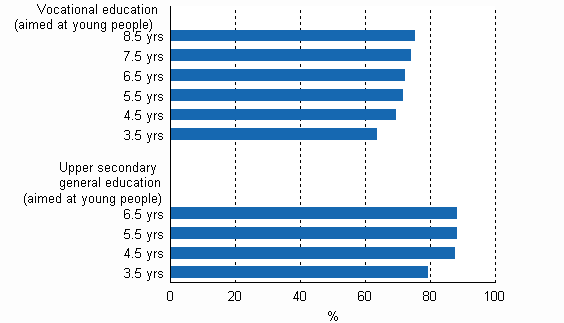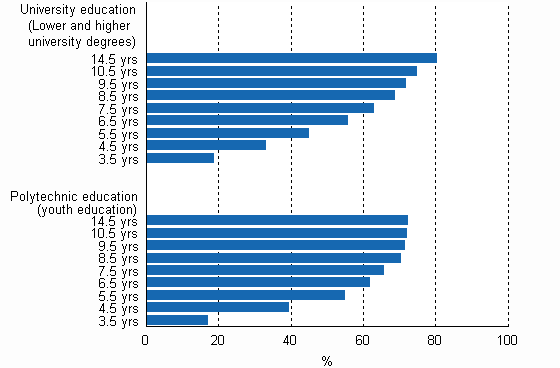Published: 15 March 2011
Completion of vocational education has improved
According to Statistics Finland, 63 per cent completed vocational education aimed at young people within three-and-a-half years. The completion rate for vocational education improved by 1.6 percentage points from the previous year. Men's pass rate of vocational education improved by nearly 2.5 percentage points and was nearly a percentage point higher than women's. In other sectors of education pass rates remained on level with the year before.
Pass rates for vocational and upper secondary general education in different reference periods by the end of 2009

Pass rates for university and polytechnic education in different reference periods by the end of 2009

These statistics examine the situation at the end of 2009 of students having started vocational education aimed at young people or upper secondary general education aimed at young people in 2006, polytechnic education for young people in 2005 and university education in 2004. The pass rate for a university degree in five-and-a-half years was 45 per cent. The pass rate for university degrees stayed on level with the previous year partly due to the university degree revision. According to the new degree system, as a rule all students complete a lower university degree before a higher university degree. Twenty-four per cent of the students having started university education in 2004 attained a lower university degree in five-and-a-half years while the respective share among those having started university studies in 2003 was 18 per cent. In polytechnic education aimed at young people, 40 per cent of new students attained a degree in four-and-a-half years. Matriculation examination was passed by 79 per cent of those having started to study for it three-and-a-half years earlier.
Apart from vocational education, men’s pass rate is lower than women's in all sectors of education. In upper secondary general education, men's pass rate was a couple of percentage points lower than women's. In university degrees, the difference between men’s and women’s pass rates was considerably larger. Twenty-three per cent of men had attained a polytechnic degree four-and-a-half years after starting studies, while the corresponding percentage for women was 54 per cent. During the examination period, 32 per cent of men and 55 per cent of women attained a lower or higher university degree. In the longer term, the difference seems to level off. Among those having started university studies in 1995, 73 per cent of men and almost 87 per cent of women had attained a degree after fourteen-and-a-half years of studies.
There are large differences in pass rates by field in all sectors of education. In relative terms, the highest numbers of higher university degrees were attained by students in the fields of social sciences, economics and administration and the lowest numbers by students in technology and transport. In polytechnic education, the highest pass rate of 64 per cent was achieved in the field of health, welfare and sports. At 20 per cent, the pass rate was the lowest in the field of technology and transport. In vocational education, the pass rates were the highest in the fields of humanities and education, and in welfare, health and sports, in which a qualification had been attained by 67 per cent of students. The pass rate was the lowest in the field of natural sciences, at 49 per cent.
Other statistics also indicate that studying was more interesting than in the year before. Discontinuation of education and employment during studies decreased. More detailed information is available from the statistics describing Discontinuation of education and Employment of students .
Source: Education Statistics 2011, Statistics Finland
Inquiries: Anna Loukkola (09) 1734 3678, koulutustilastot@stat.fi
Director in charge: Jari Tarkoma
Publication in pdf-format (242.4 kB)
- Tables
-
Tables in databases
Pick the data you need into tables, view the data as graphs, or download the data for your use.
Appendix tables
- Appendix table 1. Progress of new upper secondary school students (aimed at young people) studies by end 2009 (15.3.2011)
- Appendix table 2. Progress of new students studies in vocational education (aimed at young people) by end 2009 (15.3.2011)
- Appendix table 3. Progress of new polytechnic students studies by end 2009, youth education (15.3.2011)
- Appendix table 4. Progress of new university students studies by end 2009, lower or higher university degrees (15.3.2011)
Updated 15.3.2011
Official Statistics of Finland (OSF):
Progress of studies [e-publication].
ISSN=1799-1021. 2009. Helsinki: Statistics Finland [referred: 24.12.2025].
Access method: http://stat.fi/til/opku/2009/opku_2009_2011-03-15_tie_001_en.html

